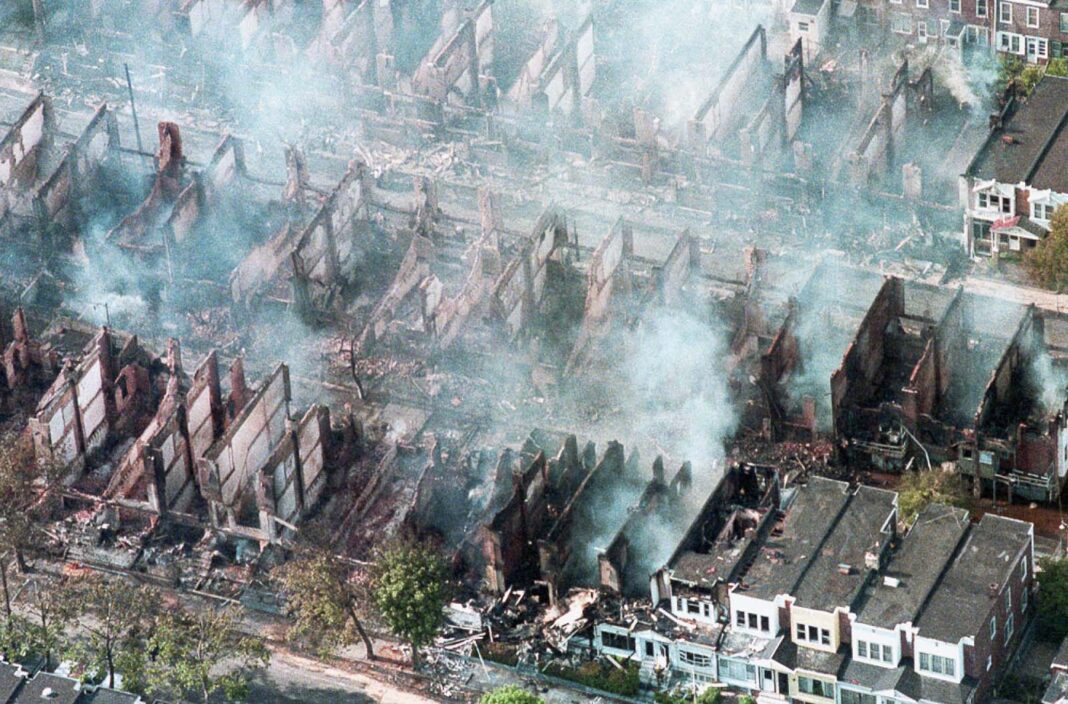On May 13, 1985, Philadelphia witnessed one of the most shocking police actions in American history.
A standoff with the radical group known as MOVE escalated into a full-scale assault that ended with a bomb being dropped on a residential neighborhood.
The explosion and resulting fire killed 11 people, destroyed 61 homes, and left more than 250 residents homeless.
Rare photos from that day capture not only the devastation but also the extraordinary breakdown of trust between a city and its people.

MOVE members in front of their original headquarters in the Powelton Village area of Philadelphia. Photo by Leif Skoogfors.
MOVE, short for the “Christian Movement for Life,” was founded in 1972 by John Africa, born Vincent Leaphart. The group preached a philosophy of rejecting materialism, embracing natural living, and protecting animals.
Its members lived communally, adopted the surname “Africa,” and openly challenged authority in ways that drew both attention and controversy.
Their lifestyle, however, put them on a collision course with city officials and law enforcement.
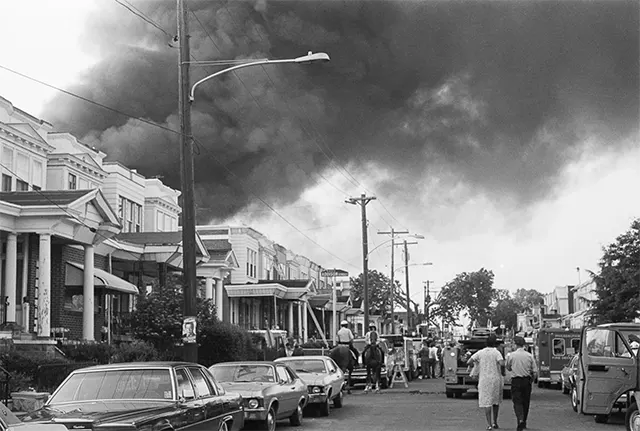
Smoke billows from the spreading fire after the bombing.
The first violent clash came in 1978, when police attempted to evict the group from its home in Powelton Village. A gun battle broke out, leaving one officer dead and several others wounded.
Nine MOVE members were convicted in the officer’s death and handed sentences of up to 100 years.
By 1981, the remaining members had relocated to a row house on Osage Avenue in West Philadelphia.

The three blocks destroyed by the fire.
The new compound quickly became a source of friction in the neighborhood. Windows were boarded shut, a bunker was built on the roof, and loud political messages were blasted through bullhorns at all hours.
Neighbors complained constantly, while authorities accused MOVE of contempt of court, stockpiling weapons, and creating a public menace.
By the mid-1980s, the group was labeled a terrorist threat by both the mayor and the police commissioner, setting the stage for the deadly confrontation.
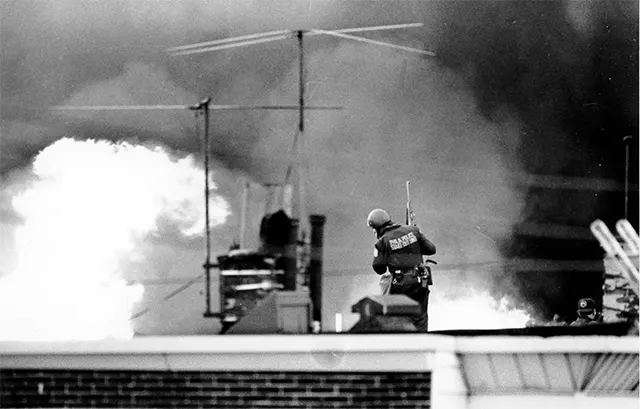
A police officer looks on as the blaze spreads. Photo by George Widman.
On the morning of May 13, police arrived with arrest warrants for four MOVE members. Negotiations never gained traction.
Within hours, a fierce gunfight erupted, with more than 500 officers firing over 10,000 rounds into the fortified house. Water cannons and tear gas were unleashed, yet MOVE refused to surrender.
Even after appeals for calm from city leaders, Police Commissioner Gregore Sambor made a decision that would scar Philadelphia’s history.
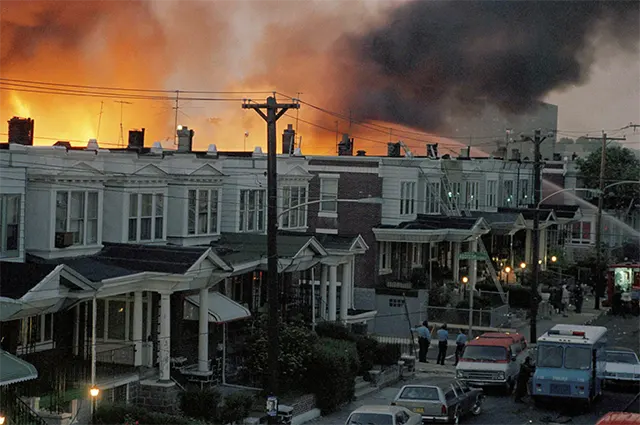 At 5:28 p.m., a state police helicopter released a satchel bomb made of C-4 explosives and Tovex TR2 dynamite, supplied by the FBI. The target was the rooftop bunker.
At 5:28 p.m., a state police helicopter released a satchel bomb made of C-4 explosives and Tovex TR2 dynamite, supplied by the FBI. The target was the rooftop bunker.
The detonation tore through the structure, but it also sparked a massive fire. Firefighters, fearing MOVE gunfire, were ordered not to intervene.
The blaze spread rapidly, leaping from house to house across Osage Avenue, reducing an entire city block to ash.
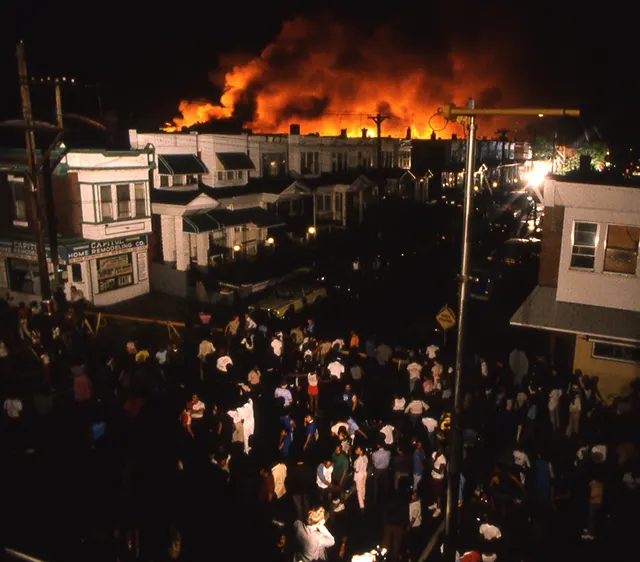
A crowd watching a row of buildings go up in flames in Philadelphia following the May 13, 1985 bombing.
When the flames were finally extinguished four hours later, the destruction was staggering. Eleven people inside the MOVE house were dead, including founder John Africa, five other adults, and five children ranging from seven to 13 years old.
Only two people managed to escape. The inferno obliterated 61 homes, displacing 250 residents and scarring a neighborhood forever.
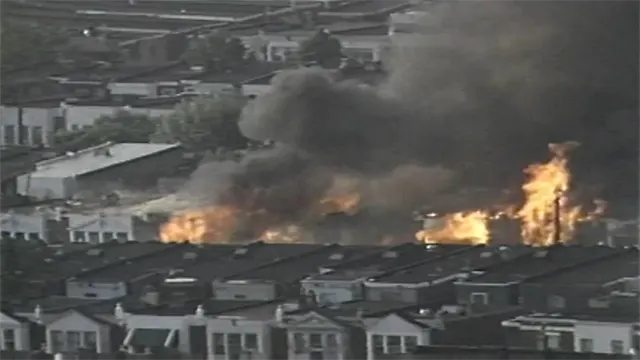 Public outrage followed, but accountability was elusive. Despite multiple investigations and official apologies, no city officials or police commanders faced criminal charges.
Public outrage followed, but accountability was elusive. Despite multiple investigations and official apologies, no city officials or police commanders faced criminal charges.
A decade later, in 1996, a federal jury ordered Philadelphia to pay $1.5 million in damages to survivor Ramona Africa and relatives of two victims, ruling that the city had used excessive force and violated constitutional protections.

Dozens of houses continue to smolder the day after the bombing.
Efforts to rebuild the neighborhood began that same year, with the city and a private developer constructing new homes for displaced families.
But the rebuilding effort soon became another tragedy. Investigations revealed shoddy construction, homes that failed to meet code, and unsafe living conditions.
By 2005, the city abandoned attempts to repair the homes altogether, instead offering residents buyouts of $150,000 each. Most accepted, leaving behind the block that had once been their community.
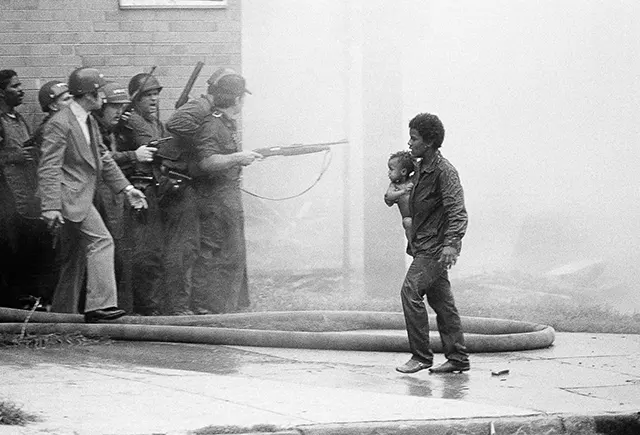
A man flees for safety with a child while police assault the MOVE headquarters. Photo by Peter Morgan.
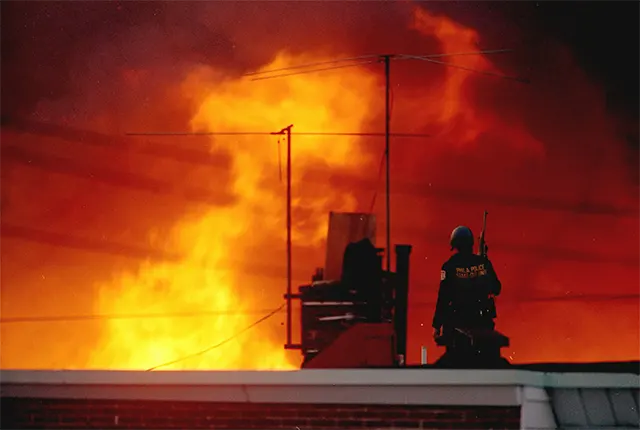
A Philadelphia police officer watches a block of houses burn. Photo by George Widman.
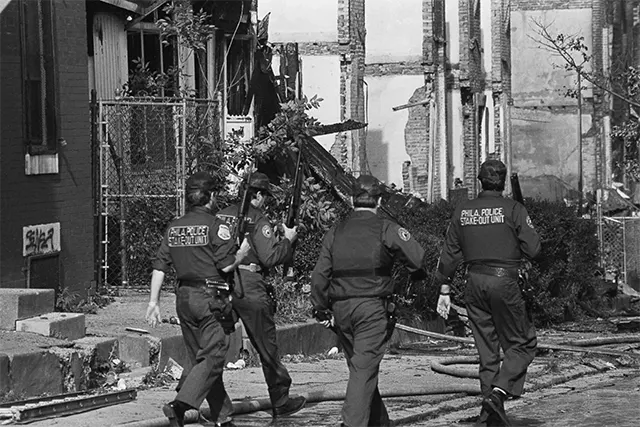
Police officers walk through the destroyed neighborhood the day after the bombing.

A worker transports the remains of a body found in the rubble. Photo by George Widman.
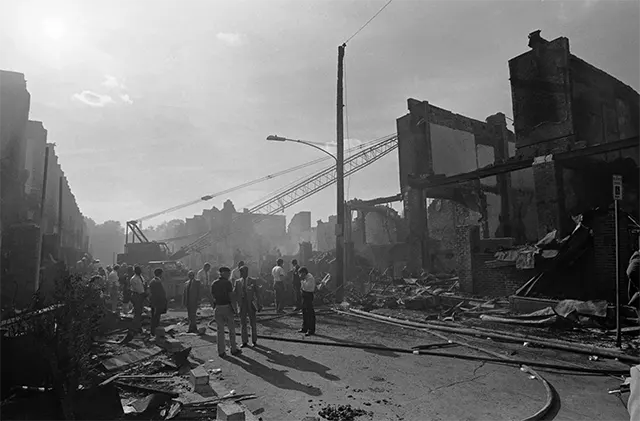
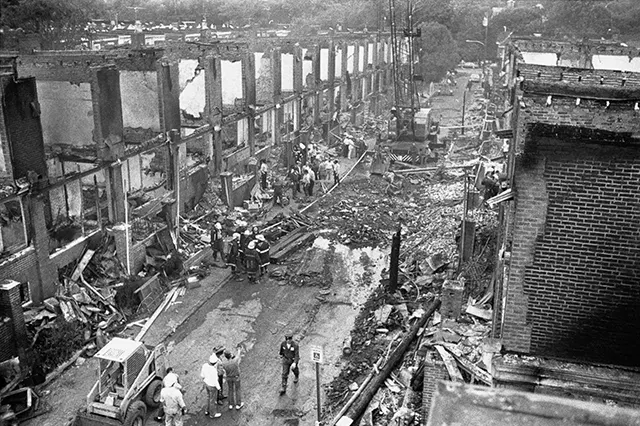
Investigators search the rubble for bodies. Photo by George Widman.
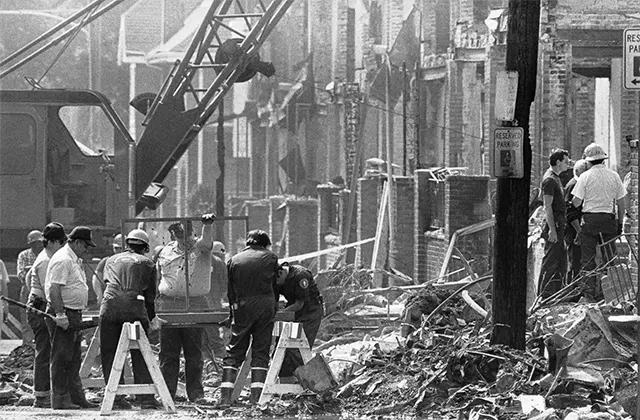
Investigators use a screen to sift through debris. Photo by George Widman.
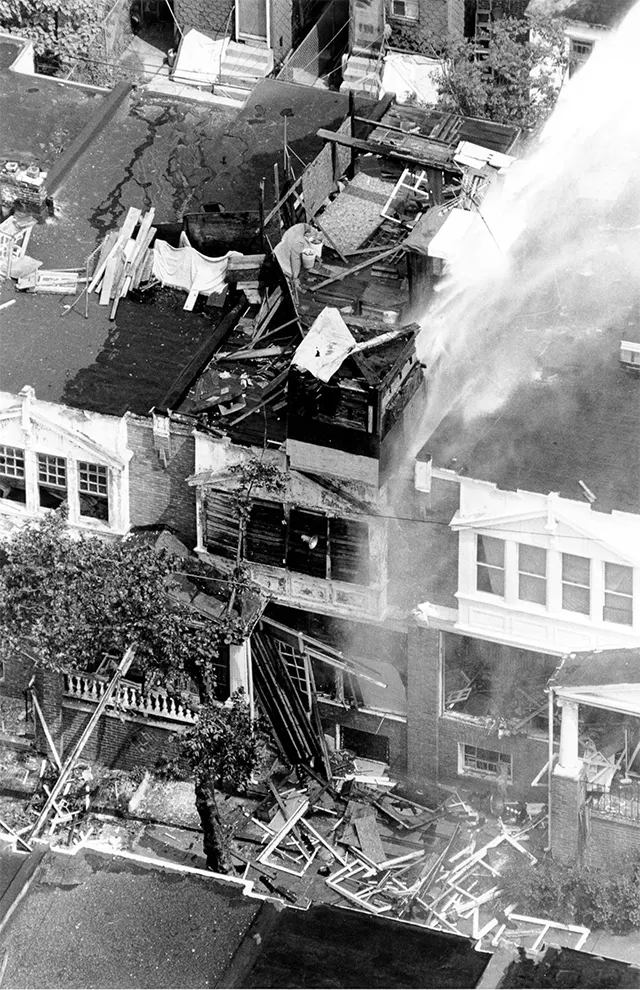
The fortified MOVE headquarters is hit with a deluge of water by firefighters. Photo by Amy Sancetta.

Workers remove the remains of a body from the rubble. Photo by J. Scott Applewhite.
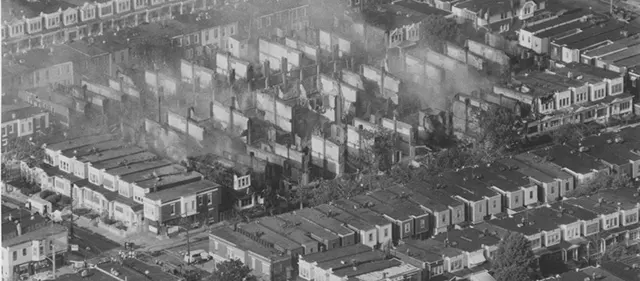
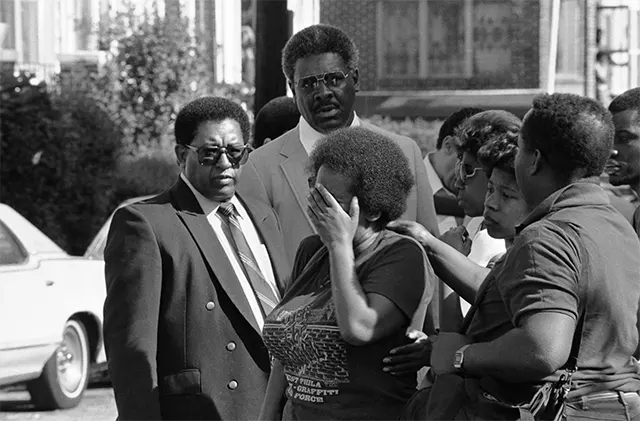
A woman mourns after returning to her destroyed neighborhood. Photo by Jack Kanthal.
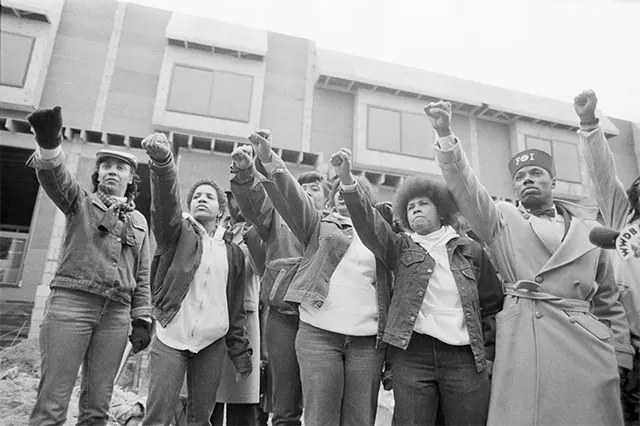
Mourners stand in front of the former MOVE headquarters as the funeral procession of John Africa passes.
(Photo credit: Mashable / Alex Q. Arbuckle; 1985: When Philly police dropped a bomb on a residential neighborhood / Wikimedia Commons / Britannica).
